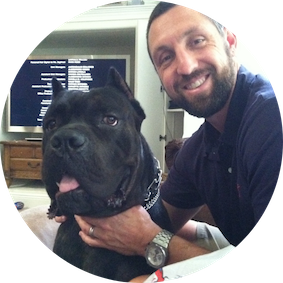
Did you know that your canine friends spend as much as half of their days asleep? If you have an older dog or a bigger breed, they might spend even more time sleeping than that.
When your dog is sleeping, you might hear them making slight barking noises, twitching, and paddling their paws. We've all wondered from time to time: is my dog dreaming? Do dogs dream?
If dogs do dream, what the heck are they dreaming about?
Let's take a deep dive into the topic to learn what we know about dogs, sleeping, and dreaming.
The best way we know as humans to determine whether or not dogs dream is to take a look at how the canine brain works and compare it to what we know about the human brain. Humans and dogs have a similar physical structure to their brains. During sleep, brain wave activity follows a similar pattern between both dogs and humans.
Scientists have connected the electrical impulses in the human brain to the state of dreaming. Using an electroencephalogram (or EEG for short) to test sleeping dogs' brain wave activity, it's been found that dogs also have similar electrical impulses during sleep. Basically, it does seem like dogs dream, too.
Dog Sleep Patterns and Dreams
Humans have a number of different stages of sleep that they cycle through when they sleep at night. Dreaming is most likely to happen during REM sleep, and it appears that this is also true for your canine companions.
When your dog enters REM sleep you might notice that their breathing sounds irregular and their eyes are moving rapidly. Their eyelids might flicker during this time. At this stage, you're most likely to notice the signs that your dog is dreaming.
Are you interested in improving the sleeping habits of your dog? If so, check out this article.
Signs Your Dog Is Dreaming
If you've already spotted some of the signs of REM sleep in your furry friend, then there is a chance they are actively dreaming. It takes a while for a dog to cycle into the REM stage of sleep, so they're less likely to dream if they're taking a quick nap than if they're sleeping through the night.
There are a number of other signs your dog might be sleeping beyond the signs of REM sleep. In the same ways that humans will sometimes react subconsciously to the dream images their experiencing, dogs will sometimes whine, whimper, growl, or bark. You might also notice that their are moving their legs as if they're running.
Dogs might also shudder or twitch while they're dreaming.
What Do Dogs Dream About?
What do dogs dream about when they twitch, bark, or cry?
This question is pretty much impossible to answer, as we can't directly see what it's like to be a dog. It's fascinating to wonder about, though!
Scientists believe that it's likely that dogs dream in a similar way that humans do. However, that doesn't tell us much, as there isn't necessarily a scientific consensus into why we dream, what dreams mean, and what function they serve.
That being said, many people believe that dogs are dreaming about their usual activities and reliving their daily experiences. When you hear your dog softly barking as she sleeps, it's possible she really is just barking at a dream-squirrel. Unfortunately, though, we'll probably never know for sure!
One thing we do know is that larger dogs tend to dream less frequently within their sleep pattern than small dogs. It seems that a tiny dog might appear to be dreaming as often as once every ten minutes, while a larger dog might only display signs of dreaming once every 90 minutes.
How Can You Tell the Difference Between Dreaming and a Seizure?
One thing that concerns pet owners sometimes is how to tell the difference between a perfectly healthy, dreaming dog and a dog that's having a seizure. This is understandable, as there are some similarities between the two occurrences in appearance.
When a dog has a seizure, he or she is experiencing an abnormal motor response. This originates in the brain. On the other hand, dreaming is a totally normal pattern of electrical impulses in their brain.
Twitching muscles and paddling feet are technically both symptoms of seizures and dreaming, however, they'll look very different in practice. The twitches your dog experiences during a dream will be much more gentle than those he would have if he were having a seizure. Seizure twitches would be more violent and you might even notice that their limbs have become rigid and stiff.
When a dog is having a seizure, you might also notice foam or drool coming from his mouth. You'll also be able to tell the difference once the dog regains consciousness. A dog that has been dreaming might be a little sleepy but he'll be fine, while a dog who had a seizure might be distressed and disoriented.
Do Dogs Have Nightmares?
It's natural to wonder if your dog ever has bad dreams the same way people do. While we can't know for sure, some experts do think that dogs can indeed have dreams that are unpleasant. This is the theory because dogs are likely using their dreaming time to process their emotions and experiences in a similar way that humans do.
If your dog is having a bad dream, you might hear them yelp or cry. If you notice this occurring, don't wake them up. Instead, let them sleep.
You can softly use their name and say reassuring words out loud. You can also take this time to softly pet their back to help support them while they're experiencing a hard and difficult dream.
If your dog seems to be having full body spasms or is making uncharacteristic screams or yelps, it's possible they're experiencing a seizure. If this is the case, you'll want to call your vet right away. They can help direct you on what to do next.
Should You Wake a Sleeping Dog?
Have you ever heard the saying "let sleeping dogs lie"? Apparently, it's not just a cute saying, but legitimately good pet-owner advice.
While it can vary between dogs, on average they tend to sleep between 12 and 14 hours every day. If it seems like your dog is having a nightmare, it can be tempting to try and wake them up. However, you don't want to disrupt a dog while they're experiencing REM sleep.
If you imagine what it's like when you wake up from a nightmare, it can help you understand why you might not want to wake a sleeping dog. When you first wake up you can be disoriented, startled, and scared. It can take a few moments to realize it was all just a dream.
Dogs can have this same experience, but the consequences can be more serious. If you wake a dog while they're having a nightmare, it's possible that you could get unintentionally bitten.
Also, think about how it feels when you get woken up in the middle of a dream without letting the dream reach its resolution. It's incredibly frustrating! Your dog doesn't want to experience this, either.
If you absolutely have to wake a dog when they seem like they're having a bad dream, don't shake them or touch them. Instead, say their name softly or make some gentle noise in the room. It's possible they will wake up on their own without you jostling them awake.
When they do wake up, speak warm words and pet them lovingly. This is a great time to show some TLC to your canine friend. Who wouldn't want some comfort after a bad dream?
Does Your Dog Have a Comfy Place to Sleep?
As we've learned, dogs spend a big chunk of their day sleeping. If your dog is spending more than half of his or her day sleeping on the floor, you might consider buying them a more comfortable spot to snooze.
At Bully Beds, we make orthopedic dog beds that are unsurpassed by other products on the market. Providing joint comfort, stability, and luxury for large-breed canines, this is the perfect place for your big dog to catch some z's.
These beds are easy to clean and care for, and they won't flatten out over time. We are so confident that you and your dog will be satisfied by our Bully Beds that we offer a 30-day trial period with every purchase.
Is it time for you to try out our Bully Bed for your large breed dog? If so, check out our Original Bully Bed today!




